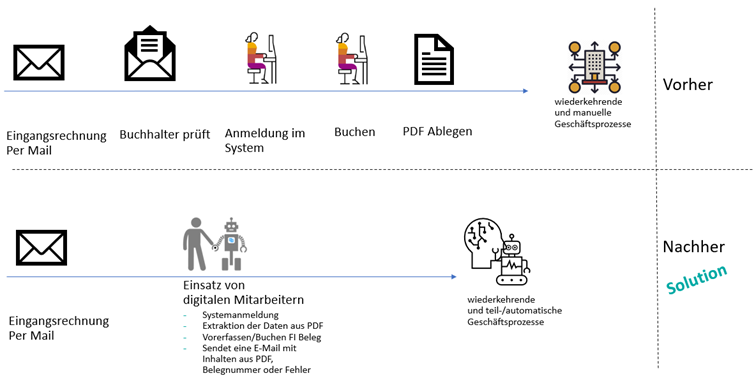
Who does not know that? Instead of dedicating yourself to exciting topics at work, monotonous and repetitive tasks keep you from it. At the end of the day, this creates the impression of having accomplished almost nothing. In this blog post, you will learn from an example in the accounting environment how process automation helps companies to (partially) automate certain tasks and employees have more time for other topics.
What is process automation?
In process automation, also as Robotic Process Automation (RPA), repetitive, manual, time-consuming or error-prone activities are partially or fully automated by digital employees in the form of bots. In the following, we use an example use case to show the advantages of process automation.
When does process automation make sense?
Processes for which automation makes sense are activities whose Processes are defined by fixed rules or specifications are. They can last a few minutes but are often repetitive or take several days and be complex. Processes can be cross-system and also be completed by different employees. Depending on the process, the following goals can be achieved:
Fig. 1: Goals of process automation (Source: CONET)
How SAP supports process automation
The SAP Business Technology Platform (BTP) is the basis for SAP Process Automation (SPA). This combines the functions of SAP Workflow Management and SAP Intelligent RPA (iRPA) with a powerful and intuitive Low-code and no-code development environmentto effectively drive automation. The automations can be integrated and executed in a workflow.

Abb. 2: (Those: SAP)
Using SAP SPA, both SAP and non-SAP processes can be individually automated end-to-end, regardless of technology. In addition, SAP provides with the SPA Store numerous building blocks for various business processes and workflows to disposal. These are ready-made solutions and can be used out-of-the-box or adapted to your own processes as required.
An agent is required for the automation to run. This runs either on the user’s desktop or on a client running on a server. It will do this between modes “attended mode” and “unattended mode” distinguished. In order to be able to start the automations, there are various triggers that determine the corresponding mode. This can be, for example, new e-mails, a sent form or a call via an interface. The automated process can also be started manually or time-based by a user, the possibilities here are very diverse.
Workflows are used for many automations. An automation can be embedded in a workflow or run autonomously. The SPA Suite makes it possible to set up automations to monitor in detail. This is absolutely necessary, especially in unattended mode, and should be planned for from the start.
Accounting Bot – Post vendor invoice
Anyone who works in accounting probably knows the following processes only too well: Finding the right e-mail among countless new e-mails in the inbox, reading the data from possibly different invoice designs, transferring every single piece of information to the SAP system using tiresome and error-prone copy & paste, and finally attach the right PDF to the booking after several clicks. Instead of having to go through these time-consuming and monotonous process steps individually, a Accounting Bot can be used.

Abb. 3: (Those: SAP)
The best-practice process “posting vendor invoices” can be carried out fully automatically as a bot activity. here the bot takes over many manual and simple tasks. The use case was programmed on vendor invoices that reach the company via email. How often on the day the bot should book can be set in advance.
First, the accounting bot checks the mailbox for invoices. When it has found matching emails, the bot logs into SAP. Become through AI elements all necessary data is extracted from the PDF invoice and the bot posts them using transaction FB60. The PDF is then uploaded to SAP and attached to the booking.
If not enough data can be entered in the document, the bot enters all account assignments as far as possible and enters the document. With a time stamp, the pre-registration becomes clear. This enables quick manual control by the bot. Thus, all the different cases that can arise when posting a vendor invoice are covered by the bot.
In this video we show you how an accounting bot automatically posts vendor invoices.
In this demo, if the run is successful, the document number, company code and posting date are stored in Excel under the “Successful” tab and in the event of an error, the parked document number, the data from the PDF and the error message are stored in Excel under the “Failed” tab. A workflow could also be triggered here so that the relevant processor can check the error and correct it if necessary.
If the bot has processed all the invoices in the mailbox, the Excel file is sent to the accountant or mailbox owner as an e-mail confirmation with brief statistics on how many invoices were successfully posted, parked or failed. The user can briefly view the results and turn to other important activities during execution.
A bot like the one shown in this use case can be used with a very manageable amount of effort. After a brief requirements analysis, such a bot can be built for your system. Many standard process steps can be adopted, what the development time decreases. You can then specify when and how often the bot should run and it can relieve users of their work.
Conclusion
As can be seen from the Accounting Bot example, process automation can simplify your everyday work in the long term and thus free up resources for value-adding activities! In addition, the process is extremely accelerated and better data quality is achieved, since manual copy & paste is very error-prone, as in this example. With SAP Process Automation, SAP offers a powerful and intuitive platform for automation that goes beyond the boundaries of SAP.
CONET will be happy to support you in automating your processes!
We work with you to develop the process model and strategy and build the technology and processes for you. We also train your employees if they are to take over parts of the process automation.
To the website

As a Mobility & SAP Consultant at CONET Business Consultants GmbH, Dominik Alpers advises the customers of the SAP consulting company on all questions relating to mobile solutions, from mobility strategy and process issues to infrastructure aspects and mobile apps and their development.
Source: https://www.conet.de/blog/prozesse-im-accounting-automatisieren-mit-sap-prozessautomatisierung/



